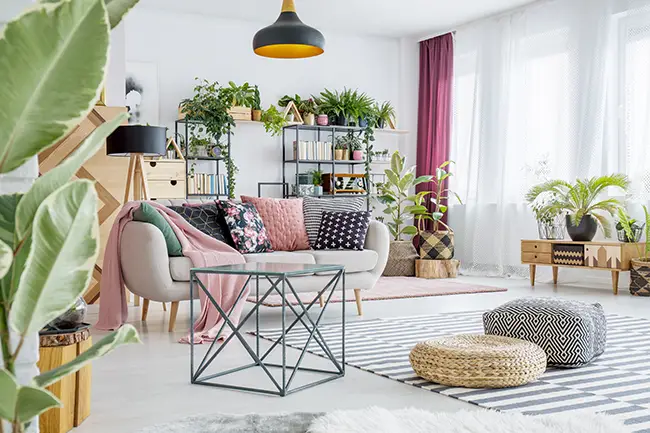Indoor Plants: Perks and Pitfalls in Home Decor
Published on October 6, 2023 | 5 Minute read

Melanie
Ortiz Reyes
Content Specialist
Plants are one of nature's finest gifts, and they've become an increasingly popular element in home decor. Whether you're a homeowner with a green thumb or a homebuyer looking to add some life to your space, you may consider introducing plants into your living environment.
Plants are not only an aesthetic delight but also contribute to our well-being. They have the power to transform the atmosphere of any space, making it feel more inviting and refreshing. As more people recognize the remarkable benefits of indoor plants, the trend of botanical decor is on the rise. Whether you have a cozy cottage or a modern apartment or are in the process of purchasing your dream home, exploring the world of indoor plants could be the perfect way to create a harmonious and natural ambiance. However, making an informed decision is essential, considering both the advantages and potential challenges of embracing plant-filled home decor.

Perks of Bringing Plants Home
- Enhanced Aesthetics - Plants instantly add vibrancy and character to your home decor. They come in various shapes, sizes, and colors, making finding the perfect match for your interior design easy. Whether you choose a towering Fiddle Leaf Fig or a petite succulent, plants can serve as unique focal points or complementary pieces in any room.
- Improved Air Quality - One of the most celebrated benefits of indoor plants is their ability to purify the air. They naturally filter out common toxins and release oxygen, creating a healthier indoor environment. Plants can be an excellent addition for homeowners concerned about air quality, especially in urban areas.
- Stress Reduction - Numerous studies have shown that the presence of indoor plants can reduce stress and promote a sense of well-being. Their calming effect makes them valuable in spaces where relaxation and tranquility are paramount.
- Versatility in Home Staging - If you're a homeowner looking to sell your property, incorporating plants can be a savvy home staging strategy. They provide a welcoming and fresh atmosphere, allowing potential buyers to envision themselves living in the space. Realtors and real estate agents often recommend adding a touch of green to your interiors when staging a home.
Challenges of Greening Your Space
- Maintenance and Care - While plants bring undeniable beauty, they also demand regular care. Different species have varying requirements for sunlight, watering, and humidity. Overwatering, underwatering, or neglect can lead to plant distress, affecting both their appearance and the home environment.
- Potential for Pests - Bringing plants into your home can introduce the risk of pests. Insects, such as aphids or mealybugs, can find their way into your living space through potted plants. It's essential to monitor your plants and address any pest issues promptly.
- Allergies - Some individuals may be sensitive to certain plants or pollen, leading to allergies or respiratory issues. If you or your family members have allergies, choosing plants less likely to trigger sensitivities is crucial.
- Limited Space - Adding too many plants can create a crowded or cluttered appearance in smaller homes or apartments. It's important to balance your decor and ensure your plant choices harmonize with the available space.

Choosing the Right Plants for Your Home
- Low Maintenance Options - For homeowners or homebuyers with busy schedules or minimal gardening experience, low-maintenance plants like snake plants, pothos, or ZZ plants are excellent choices. These plants require less attention and are hardy.
- Pet-Friendly Selections - If you have pets, choosing plants that are safe for them is crucial. Some common houseplants, such as lilies, can be toxic to cats or dogs. Opt for non-toxic options like spider plants or Boston ferns.
- Light Requirements - Different plants have varying light preferences. Be mindful of the natural light in your home and select plants that thrive in your specific conditions. Consider low-light plants like peace lilies or philodendrons for spaces with limited sunlight.
- Aesthetic Preferences - Ultimately, the choice of plants should align with your aesthetic preferences and the decor of your home. Consider the color palette, style, and mood you want to create when selecting plants as part of your interior design.
Maintaining Healthy Indoor Plants
- Proper Watering - Overwatering is a common issue for indoor plants. Watering your plants according to their specific requirements and not solely on a fixed schedule is imperative. Invest in a moisture meter or learn the finger test to determine when your plants need water.
- Correct Potting and Soil - Choosing the right pots and soil is vital for plant health. Make sure your pots have drainage holes to prevent root rot, and use well-draining soil suitable for the type of plants you have.
- Regular Pruning - Pruning is necessary to promote healthy growth and maintain your plants' shape. Trimming dead or yellowing leaves, as well as occasional reshaping, can keep your indoor plants looking their best.
- Monitoring for Pests - Regularly inspect your plants for signs of pests, such as discolored or damaged leaves. If you identify a pest issue, address it promptly to prevent infestations from spreading.
The decision to incorporate plants into your home is a personal one, influenced by your lifestyle, preferences, and priorities. As a homeowner or homebuyer, you should weigh the benefits of enhanced aesthetics, improved air quality, and stress reduction against maintenance challenges, potential pests, allergies, and space limitations.
If you decide to embrace the world of indoor plants, remember that the right choices in plant selection and proper care can lead to a harmonious and vibrant living space. However, if you opt for a plant-free environment, you can still achieve a beautiful and comfortable home with alternative decor elements like artificial plants.